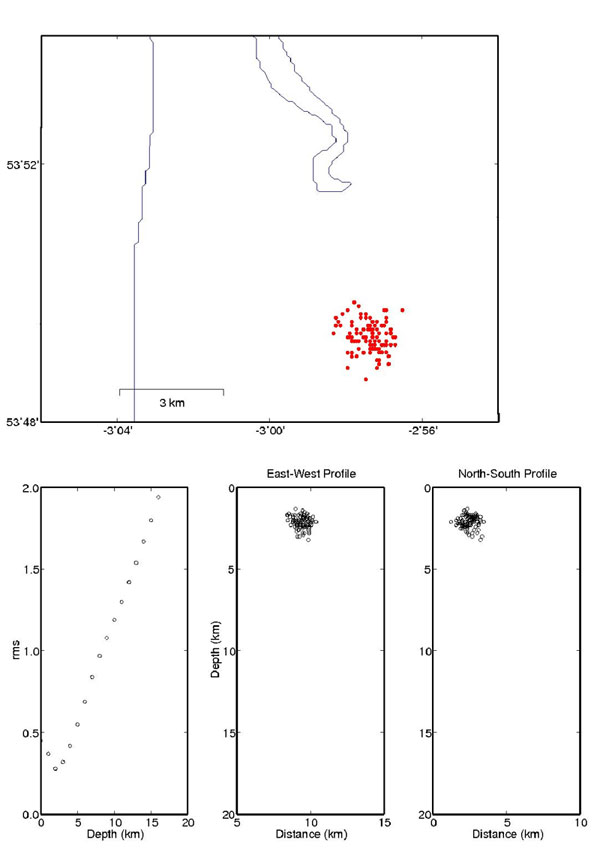Blackpool earthquake | Magnitude 1.5 | 27 May 2011
| Date | 27 May 2011 |
|---|---|
| Origin time | 00:48:46.5 UTC |
| Lat/Lon | 53.821° North / 2.956° West |
| Grid ref | 337.1 km/E / 436.5 km/N |
| Depth | 2.0 km |
| Magnitude | 1.5 ML |
| Locality | Poulton-Le-Fylde |
| Intensity | 3 EMS |
We have recently recorded magnitude 1.5 (27 May) and magnitude 2.3 (1 April) earthquakes in the Blackpool area near to the Preese Hall shale gas drilling site operated by Cuadrilla Resources.
The 27 May earthquake was felt by at least one person in Poulton-Le-Fylde.
Analysis of data from two temporary instruments close to the drill site, installed by BGS after the magnitude 2.3 earthquake on 1 April, places the epicentre of this event within 500 metres of the Preese Hall site and gives a depth of approximately 2 km.
The recorded waveforms are very similar to those from the magnitude 2.3 event on 1 April, which suggests that the two events share a similar location and mechanism (see Figure 2).
The location of the second earthquake is much better constrained than the event on 1 April.
In particular, the depth of 2.0 km is much better resolved, because of the availability of recordings from close to the epicentre.
However, the location is still only an estimate with errors of around +/- 1 km in both epicentre and depth.
We understand that fluid injection, between depths of 2–3 km, was ongoing at the Preese Hall site shortly before both earthquakes occurred.
The timing of the two events in conjunction with the fluid injection suggests that they may be related.
It is well-established that fluid injection can induce small earthquakes. Typically, these are too small to be felt.
We would not expect earthquakes of these relatively small magnitudes to cause any damage.
Further monitoring and careful analysis of any future activity is required to help understand any relationship between the injection process and nearby seismic activity.

1 April 2011 earthquake data
| Date | 1 April 2011 |
|---|---|
| Origin time | 02:34 32.3s UTC |
| Lat/Lon | 53.834° North / 2.975° West |
| Grid ref | 335.84 km/E / 437.99 km/N |
| Depth | 3.6 km |
| Magnitude | 2.3 ML |
| Locality | Blackpool, Lancashire |
| Intensity | 3 EMS |
Error analysis
We obtain estimates of the hypocentral errors by bootstrap resampling, with P- and S-wave arrival times from all stations randomly perturbed to specified maximum values, then used as a new input data set for the location program HYPOCENTER (Lienert et al., 1986).
This process is repeated many times to give an estimate of the variability in the results. The interdecile ranges of longitude, latitude and depth are then used as a robust measure of the statistical dispersion of each parameter.
In this case we used 100 iterations and the maximum perturbations for P- and S-wave arrivals were 0.25 and 0.5 seconds respectively.
The results are shown in Figure 3. Figure 3 (a) shows the resampled epicentres along with the error ellipse for hypocentre determined using the unperturbed data.
Figure 3 (b) shows the RMS error in the hypocentre determined using the unperturbed data.
Figure 3 (c) and (d) show east-west and north-south cross-sections of the resampled solutions, which clearly show the uncertainty in the depth estimate.
Errors were found to be 0.8 km, 0.8 km and 0.7 km in longitude, latitude and depth respectively.
Regional seismicity
The Blackpool region is an area of low seismicity even for the UK.
A magnitude 2.5 ML earthquake in 1970 was 5 km south-west of Blackpool.
There have also been a number of smaller earthquake immediately offshore.
The magnitude 3.7 Ulverston earthquake on 28 April 2009 was also felt in Lancashire.
Historically, the largest earthquake in the region was a magnitude 4.4 earthquake near Lancaster in 1835 with a maximum intensity of 6 EMS.
Fluid injection
Any process that injects pressurised water into rocks at depth will cause the rock to fracture and possibly produce earthquakes.
It is well known that injection of water or other fluids during processes such as oil extraction, geothermal engineering and shale gas production can result in earthquake activity.
Typically, the earthquakes are too small to be felt, however, there are a number of examples of larger earthquakes occurring.
The Hot Dry Rock Geothermal energy research project at Rosemanowes, Cornwall resulted in many thousands of induced earthquakes. However, only one, the largest with a magnitude of 2.0, was felt.
Conclusions
Our analysis of the magnitude 1.5 earthquake on 27 May places the epicentre of this event to within 500 metres of the Preese Hall site.
It occurred at a depth of approximately 2 km.
The similarity of the recorded waveforms to those from the magnitude 2.3 event on 1 April suggests that the two events share a similar location and mechanism.
The timing of the two events in conjunction with the fluid injection at the Preese Hall drill site suggests that they may be related to this.
Contact
Contact Brian Baptie for further information

- A Comparison of the Folkestone and Market Rasen Earthquakes
- Seismogenesis and State of Stress in the UK
- Monitoring Volcanic Eruptions Using Interferometry
- Particular events
- Are yesterday's earthquakes tomorrow's disasters?
- Creating 'virtual seismometers' deep inside the Earth
- Is earthquake activity related to the Moon or Sun?
- Is earthquake activity increasing?




